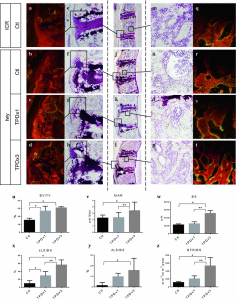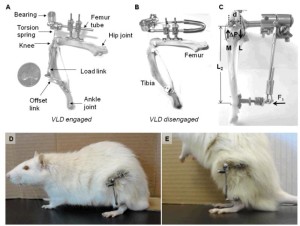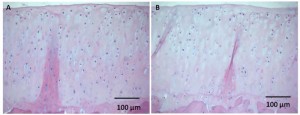Cortical bone is detrimental to longitudinal bone growth as it is not capable of interstitial growth. Osteoclasts degrade cortical bone. Degradation of cortical bone in combination with generation of tissue capable of interstitial growth is key to height growth. Thus if fluid flow increase osteoclastgenesis this should be beneficial.
SUPRAPHYSIOLOGICAL LOADING INDUCES OSTEOCYTE-MEDIATED OSTEOCLASTOGENESIS IN A NOVEL IN VITRO MODEL FOR BONE IMPLANT LOOSENING
“We aimed to develop an in vitro model for bone implant loosening, allowing analysis of
biophysical and biological parameters contributing to mechanical instability-induced
osteoclast differentiation and peri-implant bone loss. MLO-Y4-osteocytes were mechanically
stimulated for 1h by fluid shear stress using regimes simulating 1) supraphysiological loading
in the peri-prosthetic interface (2.9+/-2.9Pa, 1Hz, square wave),{This is below the minimum chondregenic range which is about 0.1MPa or 100Pa} 2) physiologic loading in the
cortical bone (0.7+/-0.7Pa, 5Hz, sinusoidal wave), and 3) stress shielding. Cellular
morphological parameters, membrane-bound RANKL expression, gene expression
influencing osteoclast differentiation, nitric oxide release and caspase 3/7-activity were
determined. Either Mouse bone marrow cells were cultured on top of loaded osteocytes or
osteocyte-conditioned medium was added to bone marrow cells. Osteoclast differentiation
was assessed after 6 days. We found that osteocytes subjected to supraphysiological loading
showed similar morphology and caspase 3/7-activity compared to simulated physiological
loading or stress shielding. Supraphysiological stimulation of osteocytes enhanced osteoclast differentiation by 1.9-fold compared to physiological loading when cell-to-cell contact was permitted{this is not a bad thing as degradation of bone could potentially be beneficial for height growh}. In addition, it enhanced the number of osteoclasts using conditioned medium by 1.7-fold, membrane-bound RANKL by 3.3-fold, and nitric oxide production by 3.2-fold. The stimulatory effect of supraphysiological loading on membrane-bound RANKL and nitric oxide production was higher than that achieved by stress shielding. In conclusion, the in vitro model developed recapitulated the catabolic biological situation in the peri-prosthetic interface during instability that is associated with osteoclast differentiation and enhanced RANKL expression. The model thus provides a platform for pre-clinical testing of pharmacological interventions with potential to stop instability-induced bone implant
loosening.”
“[There’s] a specific role for osteocyte communication with osteoclasts “<-Osteoclasts, the cells that break down and reabsorb bone, stem from monocytes and macrophages rather than osteogenic cells.
“The decoy receptor for RANKL, osteoprotegrin (OPG), is released by osteocytes upon
physiological mechanical loading. ”
“Supraphysiological loading had a flow velocity that was 5.6-fold higher, and the wall shear stress rate that was 4.0-fold higher compared to physiological loading”
“Sixty minutes of supraphysiological loading on MLO-Y4 osteocytes did not change the
cell area, cell perimeter or cell feret’s diameter compared to physiological loading or stress
shielding”<-it would be beneficial if it did because it would indicate that the stem cells could possibly change in diameter.
Osteoblasts, Osteoclasts, and Osteocytes: Unveiling Their Intimate-Associated Responses to Applied Orthodontic Forces
the remodeling process to stimulate osteoclast formation and bone resorption of the microdamaged area. During the resorption process, growth factors in bone are released, which attract and activate osteoblasts to form new bone under a canopy of bone lining cells.”




 Note extracellular fluid is listed as a factor and extracellular fluid flow can be modified by LSJL.
Note extracellular fluid is listed as a factor and extracellular fluid flow can be modified by LSJL.